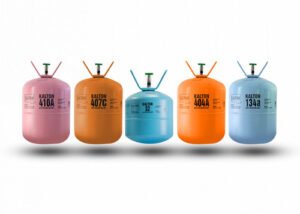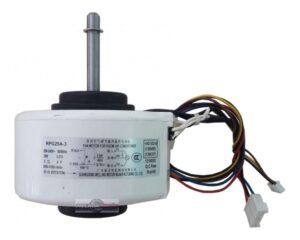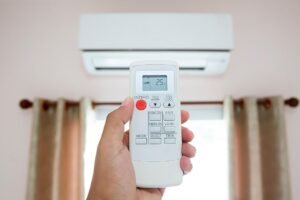Air Conditioner Expansion Valve
₹2,499.00 – ₹4,499.00
What is an Air Conditioner Expansion Valve?
An air conditioner expansion valve is a critical component in the refrigeration cycle of an air conditioning system. It serves as a control device that regulates the flow of refrigerant from the high-pressure side of the system to the low-pressure side. This regulation is essential for the effective functioning of the air conditioning system, ensuring that the refrigerant is appropriately metered in its transition from liquid to gas state. By doing so, the expansion valve plays a vital role in achieving the desired cooling effect in indoor environments.
There are various types of air conditioner expansion valves, including thermal expansion valves (TXV) and electronic expansion valves (EEV), each with distinct mechanisms for regulating refrigerant flow. The proper functioning of the expansion valve is paramount, as any malfunction can lead to inefficient cooling, increased energy consumption, and potential damage to the system. Thus, understanding the air conditioner expansion valve’s role is essential for diagnosing issues and maintaining an efficient air conditioning system, ultimately contributing to comfort and energy savings for users.
Types of Expansion Valves
Expansion valves are critical components in air conditioning systems, playing a pivotal role in regulating refrigerant flow based on the cooling load. The most common types of expansion valves include Thermostatic Expansion Valves (TXVs), Electronic Expansion Valves (EEVs), and capillary tubes. Each type exhibits distinct operational features, applications, advantages, and limitations, making them more suitable for certain scenarios.
Thermostatic Expansion Valves (TXVs) are widely used in various air conditioning systems. These valves operate based on the temperature of the refrigerant leaving the evaporator. When the temperature rises, the TXV opens to allow more refrigerant to flow in, maximizing cooling efficiency. The key advantages of TXVs include their ability to maintain a consistent superheat level, which enhances system performance and prevents compressor damage. However, their mechanical components may require periodic maintenance and can be sensitive to external conditions.
On the other hand, Electronic Expansion Valves (EEVs) provide a more precise control mechanism compared to TXVs. They utilize sensors and electronic controls to adjust refrigerant flow dynamically, responding to real-time changes in system demands. This feature allows EEVs to optimize energy efficiency, reduce refrigerant leakage, and ensure better performance under variable loads. Despite their advantages, EEVs are generally more complex and expensive to install and maintain than traditional expansion valves.
Capillary tubes, a simpler and more economical option, are often used in smaller, low-capacity systems. These fixed-geometry devices offer a straightforward design, where the restriction of refrigerant flow occurs through a narrow tube. While capillary tubes are easy to install and require no moving parts, their lack of adjustability limits their effectiveness in varied operating conditions, making them suitable only for specific applications. Each type of expansion valve has its unique merits and limitations; the choice largely depends on the specific requirements of the air conditioning system in question.
Signs of a Failing Expansion Valve
Recognizing the signs of a failing air conditioner expansion valve is crucial for maintaining optimal system performance. One of the primary symptoms is fluctuating temperatures throughout the cooled space. Users may notice that certain areas of their home are consistently warmer or colder than others, which can indicate improper refrigerant flow due to a malfunctioning expansion valve.
Another common indicator is the presence of ice buildup on the evaporator coils. When the expansion valve fails to regulate the refrigerant properly, it can lead to excessive cooling and condensation, resulting in ice forming on the coils. This blockage not only impairs air circulation but can also create additional strain on the entire air conditioning system, potentially leading to more severe issues if left unaddressed.
Refrigerant leakage is also a significant warning sign of an expansion valve issue. A failing valve may not seal properly, causing refrigerant to escape from the system. Low refrigerant levels can lead to decreased efficiency and put stress on the compressor, further jeopardizing the functionality of the air conditioning unit. Homeowners should periodically check their system for signs of leaks, as this can indicate the need for immediate professional intervention.
It is important to address these symptoms promptly to avoid costly repairs and ensure the longevity of the air conditioning system. Ignoring early warning signs can lead to more extensive damage and potentially require a complete system replacement. Regular maintenance and inspections can help identify issues before they escalate, ensuring that the air conditioning unit operates efficiently and effectively throughout its lifespan.
Replacing or Repairing the Expansion Valve
In assessing whether an expansion valve requires replacement or repair, the first step is to diagnose the symptoms correctly. Indicators such as inconsistent cooling, ice buildup on the refrigerant lines, or unusual sounds from the air conditioning unit can suggest that the expansion valve is malfunctioning. Once these symptoms are identified, gathering the necessary tools is essential for the assessment and repair process. Key tools include a multimeter, basic hand tools, safety goggles, and gloves, which protect against any refrigerants that may escape during the evaluation.
Before beginning the repair or replacement process, safety precautions must be observed. Ensure that the air conditioning system is turned off and disconnect the power supply to prevent any electrical hazards. If applicable, recover the refrigerant using a recovery machine, as releasing refrigerants into the atmosphere can pose environmental risks and may violate local regulations.
When you are ready to proceed, examine the expansion valve for signs of physical damage, wear, or leaks. If the valve appears to be clogged or defective, the next step is to determine if a repair is viable or if a complete replacement is necessary. For minor issues, such as blockages or minor leaks, repairing the valve may suffice and can be cost-effective. However, significant damage often necessitates replacement. The decision should consider the age of the unit and overall efficiency.
It is vital to recognize when to consult a professional technician. Complex problems, especially those involving system pressures or electrical components, warrant professional assistance to avoid further damage or safety risks. A qualified technician can provide a thorough evaluation and recommend the best course of action, ensuring that the air conditioning system operates efficiently and effectively after the intervention.
Maintaining Your Air Conditioner for Longevity
To ensure the longevity and efficiency of your air conditioning system, regular maintenance is paramount. This practice not only extends the life of the system but also enhances energy efficiency, which can lead to significant cost savings on utility bills. One critical component that requires attention is the air conditioner expansion valve. Regular inspections can help in identifying potential issues before they escalate into expensive repairs.
Firstly, it is advisable to schedule professional maintenance at least once a year. During these inspections, HVAC technicians can examine the expansion valve alongside other essential components of the system. They will assess its functionality and check for any signs of wear or damage that could affect performance. Promptly addressing any identified issues can prevent system breakdowns and maintain optimal cooling output. Additionally, it is essential to keep the surrounding area of the outdoor unit clear of debris, such as leaves and dirt, which can restrict airflow and hinder performance.
Besides professional maintenance, homeowners can perform simple tasks to aid in the upkeep of their air conditioning systems. Regularly changing or cleaning the air filters is crucial, as clogged filters can lead to decreased efficiency and may place unnecessary strain on the expansion valve. Homeowners should also consider inspecting the refrigerant levels periodically, ensuring that they remain within the manufacturer’s specified range. Low refrigerant levels can drastically affect the cooling process and put additional pressure on the expansion valve.
In conclusion, engaging in proactive maintenance practices for your air conditioning system is vital for maximizing its lifespan and performance. By prioritizing regular inspections of key components like the expansion valve, along with routine cleaning and servicing, homeowners can achieve a more comfortable living environment while minimizing repair costs.
| Brand Name | Amazonbasics, Blue Star, BPL, Carrier, Croma, Cruise, Daikin, Electrolux, Godrej, Gree, Haier, Hisense, Hitachi, Hyundai, IFB, Impex, Intex, Kelvinator, Koryo, LG, Livpure, Lloyd, MarQ by Flipkart, Micromax, Midea, Mitashi, Mitsubishi, Motorola, Nokia, O General, Ogeneral, Onida, Panasonic, Realme, Realme TechLife, Samsung, Sansui, Singer, TCL, Thomson, Toshiba, Trane, Vestar, Videocon, Voltas, Whirlpool, White Westinghouse |
|---|---|
| Capacity | 1 Ton To 1.5 Ton, 2 Ton |
| Type | Inverter Split, Inverter Window |
| Technician Type | With Technician, Without Technician |
1 review for Air Conditioner Expansion Valve
Only logged in customers who have purchased this product may leave a review.
Related products
-
Air Conditioner Parts
Air Conditioner Refrigerant Gas
₹1,899.00 – ₹4,999.00 Select options This product has multiple variants. The options may be chosen on the product pageRated 5.00 out of 5 -
Air Conditioner Parts
Air Conditioner Blower Motors
₹3,999.00 – ₹7,199.00 Select options This product has multiple variants. The options may be chosen on the product pageRated 5.00 out of 5 -
Air Conditioner Parts
Air Conditioner Copper Tubing
₹2,299.00 – ₹24,999.00 Select options This product has multiple variants. The options may be chosen on the product pageRated 5.00 out of 5 -
Air Conditioner Parts
AC Remote Control
₹2,899.00 – ₹4,199.00 Select options This product has multiple variants. The options may be chosen on the product pageRated 5.00 out of 5







Vimal (verified owner) –
Great value and protection. The extended warranty was definitely worth every penny and provided reliable coverage.